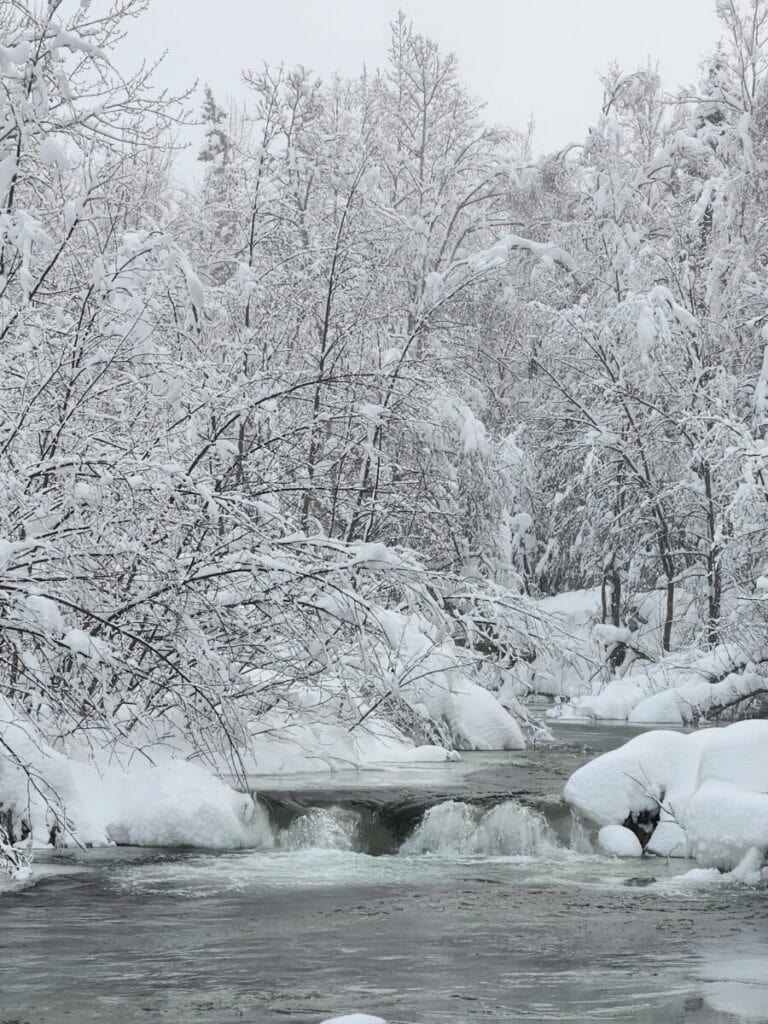I try to settle into winter, but it won’t settle. Forty inches of snow last week, another nine inches two days ago. Yesterday turned cold, a chilling fog settling down on the city. Then, last night, the wind screamed in, temperatures warmed above freezing, and snow blew off the heavily laden trees. Thump! Crash! Bang! Awake at 4:30.
Snowplows in Anchorage can’t keep up with the snow. Driving has turned into a brain-rattling roller coaster ride. Go slowly at well-traveled intersections otherwise you’ll be pitched into the car next to you. But neighborhood travel requires the opposite approach. Accelerate to get through the loose snow or you’ll get stuck. Meanwhile, kids are on their fourth “study from home” day, while parents try to juggle their work plus childcare.
This is Alaska, but there is nothing predictable in this El Nino year when the climate is changing more rapidly in the north than anywhere else.
To save myself from cabin fever, I venture outside for peace and beauty. After the first big snowfall, I dug out my dusty cross country ski boots, slid my touring skis and poles into the back of my car, and drove to the multi-use trails near my house. Nothing was groomed, but my no wax skis floated on top of a snow machine trail through the powder. Arms, legs, lungs worked together as I glided over the dazzling snow, hearing the swish of my skis and the rustle of my ski jacket. I encountered few people. A handful of skiers—we smiled and made room for each other on the narrow trail—dog walkers sinking footprints into the snow while their dogs delved deep for hidden creatures, and fat tire bikers plowing their own paths.
A few hours after the second snowfall, I packed up my gear and drove to another nearby trail. But winter does not keep its promises. My skis would not glide. Snow collected on the bottoms and no amount of pushing or scraping could keep it off. With halting shuffles, I carried on, following another set of ski tracks, until a tree lay broken across the trail. I could find no way around it except through thigh-deep snow. I took off my skis, climbed over the tree, put them back on, and shuffled a few more minutes until blocked by another fallen tree. I u-turned to the first downed tree, took off my skis and walked back to the car. In the process of taking off my skis, I noticed that my left boot was ripped at the sole on both sides. I gave up.
But, yesterday, before the wind, while the trees were still bent, broken, or heavy with snow, Jim and I hiked along Campbell Creek to discover what had changed as a result of all this dramatic weather. Snow-shoers had tromped a path ahead of us, making the trail passable, but still soft. Broken trees lay beside or near the trail, some hanging over our heads or at eye level. A pair of large birch had toppled each other and landed on top of the new iron bridge, their branches resting on one railing. A moose had visited and munched on the tender tips. The creek had also transformed. Trees had crashed from the banks, blocking or restricting the channel, anchor ice formed along each side, further narrowing the current, creating new waterfalls. The creek is never the same.
So much drama, so close to home. Here in Alaska, the only way to beat the winter blues is to get outside and marvel at nature’s changes, while at the same time recognizing how some of these changes are making our lives and those of all the other creatures who share this land more difficult.

